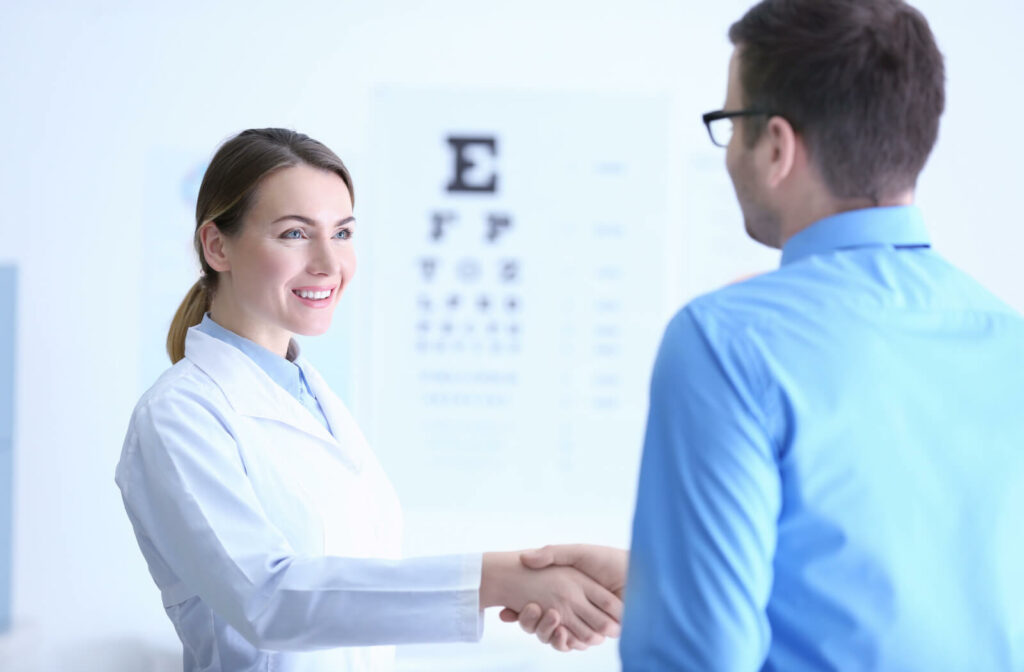With today’s technology, there are a variety of contact lenses suited to many vision needs. With so many to choose from, speaking with your optometrist is essential for finding the right lenses during a contact lens exam and fitting.
For those affected by multiple refractive errors at the same time, such as myopia (nearsightedness) and presbyopia, multifocal contact lenses can be a popular choice—but they can also help with myopia control.
Multifocal Contact Lenses: Multiple Prescriptions in a Single Lens
Multifocal contact lenses feature multiple prescriptions in a single lens to help you see clearly from near and far distances with a single contact lens. For some children, multifocal lenses can help control myopia, a refractive error that can progress during childhood.
For adults with presbyopia, multifocal lenses can help reduce the need for multiple sets of glasses or contacts. Presbyopia is an age-related condition you may develop between 37 to 40—even if you already have another refractive error, such as nearsightedness.
As you age, your eye’s lens can become less flexible, making it harder to adjust your vision for seeing objects up close. Specific areas of multifocal lenses dedicated to near vision can assist with seeing objects up close, while other parts of the lens can help you see objects that are far away.
How Do Multifocal Contact Lenses Work?
Multifocal lenses work by bringing multiple lens powers into a single lens. The design of the lens can differ based on the brand and type of multifocal lens, so it’s important to talk to your eye doctor about which type can meet your needs.
The different designs of multifocal lenses include:
- Concentric designs: Concentric multifocal lenses have the center of the lens dedicated to distance vision while alternating rings surround the rest of the lens. These surrounding rings alternate between distance and near vision.
- Aspheric designs: Aspheric multifocal lenses feature a middle zone in the lens dedicated to distance vision, while the edges of the lens assist with near vision. They can provide a gradual shift between lens powers.
The Pros & Cons of Multifocal Contact Lenses
While multifocal contacts have many benefits, they aren’t ideal for everyone. Some people choose these lenses because they can help reduce the need for reading glasses by providing clear vision from all distances.
However, multifocal contacts can take a bit to get used to. Some patients experience difficulty switching between the different lens powers, and it’s possible to feel like you’re choosing between distance or near vision rather than all-around clear vision.
Speaking with your eye doctor can help you make an informed decision when it comes to your contacts. We can recommend potential lens options after assessing your vision in a contact lens exam and fitting.
How Do You Get Multifocal Contact Lenses?
Multifocal contact lenses may be just what you need to see clearly, but you can’t buy them over the counter. You need a prescription for contact lenses, which your optometrist can provide during a contact lens exam.
This exam is similar to a comprehensive eye exam and includes a detailed analysis of your eyes to determine your prescription and ideal contact lenses.
Your contact lens exam may include:
- A lifestyle discussion about how often you wear your contacts or glasses and other relevant questions.
- An assessment of your vision to determine your prescription.
- Measurement of your corneal thickness to determine the right fit for your contacts.
After your exam, your eye doctor can recommend contacts they feel meet your vision needs and fit your lifestyle. If you’re new to contact lenses, we can provide instructions on inserting, removing, storing, and caring for your lenses too. Improper contact lens handling can lead to eye infections.
Can You Use Your Glasses Prescription for Contact Lenses?
If you’re getting contact lenses after wearing glasses for years, you may wonder if your eye doctor can use the same prescription. Unfortunately, you need a separate prescription for contacts. Your contact lenses sit directly on your eyes, while glasses sit slightly away from your eyes, so your contact lens prescription must be adjusted slightly and include extra details to provide clear vision and a proper fit for your eyes.

We’re Here for Your Contact Lens Needs
Multifocal contact lenses can help you see clearly from multiple distances and help with myopia control, which can be what you need if you have presbyopia or want to help your child reduce the long-term effects of nearsightedness.
At Eye Lab in Scottsdale, we have plenty of lenses to choose from if you’re looking for different options. Our team can recommend lenses to help provide clear, comfortable vision for you and your family. Contact us for a contact lens exam and fitting to find the right fit for your eyes.





